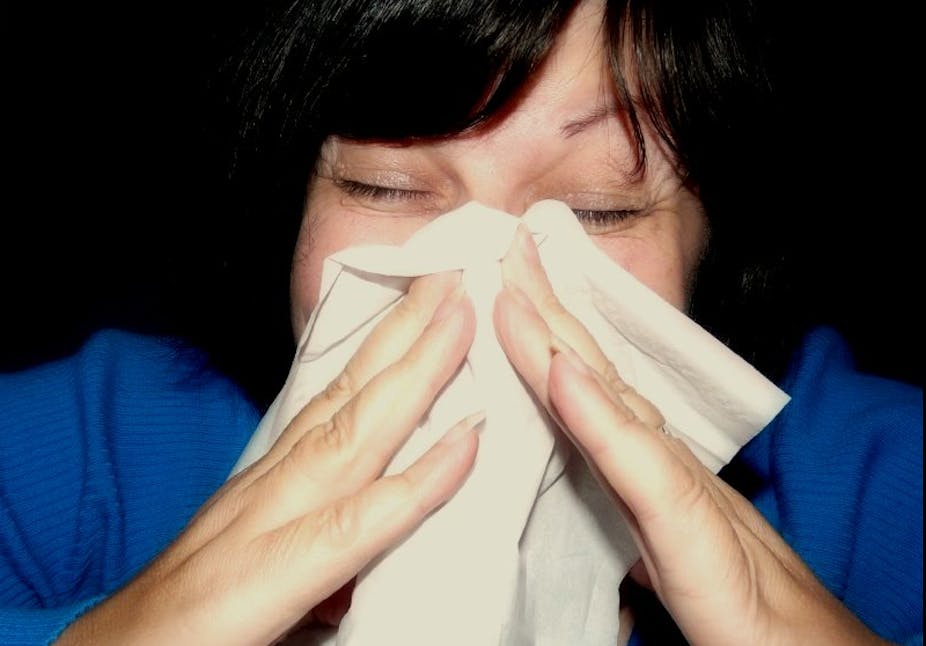The number of people suffering from influenza in Australia this year has soared compared to recorded numbers from previous years, with nearly 8,000 cases so far compared to about 2,000 last year.
We don’t know the exact causes of this rise in numbers but the reason why they’re getting so much attention is that we are only now at the beginning of the yearly winter epidemic.
Everyone knows the flu can knock you for six and can be deadly for the elderly and the really young; and the occurrence of worldwide influenza epidemics every few decades has underlined the potential lethal nature of this infection.
But the truth is that the majority of people become only mildly ill when they contract the virus. As Australia’s health minister Nicola Roxon reassured us during the 2009 pandemic – “most are mild, some are severe”.
Tropical rise
This year’s surge in influenza sufferers is a little different to other years because of the large number of cases in North Queensland and Northern Territory from January through to March.
One reason for this is excessive rain early in the year. The wet weather forced people indoors and the resulting increase in crowding led to greater transmission.
Also, because last year’s winter flu was so mild, there is a greater number of susceptible people around. The cross-immunity that comes from fighting off the flu is waning.
The predominant strain in circulation is still the swine flu that kicked off in Mexico in early 2009 leading to a pandemic.
But there is no evidence from careful testing by World Health Organisation influenza reference laboratories in Melbourne and Sydney to suggest the virus has mutated significantly or become resistant to the protective effects of current vaccines.
An epidemic of testing?
The high rates reported in Queensland are not entirely new: the number of cases recorded there has been rising in the recent past.
It is clear that doctors in Queensland are picking up more true cases of influenza but it is also important to note the majority of these are at the milder end of the spectrum. In fact, the rise in the number may be attributable to increased GP testing.
Proven influenza infection is notifiable by diagnostic laboratories. So when a general practitioner takes a swab to send to pathology laboratories for testing, the laboratory has to notify the Department of Health if the test is positive for flu virus.
Indeed, some might describe the current spike of cases in Queensland as an epidemic of testing but it must be remembered that we actually do have an annual winter epidemic of influenza. And this testing helps to have it better described in its extent and effect.
Fear of febrile convulsions
Another factor contributing to this year’s rise in numbers is people are not getting vaccinated. Some are concerned about the safety of the flu vaccine in the light of problems with fever and convulsions among children who received Fluvax last year.
There is no doubt parents are concerned about the safety of influenza vaccine for young children. And this safety issue may well have spilled over to others and reduced vaccine uptake this year.
The development last year of frequent high fever and convulsions in young children receiving the CSL influenza vaccine was of major concern. This vaccine is no longer recommended for young children.
The other vaccines used last year for children have been clearly shown to be safe in studies performed in Australia (by the National Centre for Immunisation Research, VICSAEF and other bodies), New Zealand and other countries.
Their formulation has not changed so there is considerable data supporting safe usage in many thousands of children.
High-risk groups
As an influenza researcher, I’m concerned people at high risk of complications from influenza have been deterred from getting vaccinated.
This group includes not only the ill, the elderly and the very young but also pregnant women, who were particularly badly affected by the swine flu pandemic.
These people are at higher risk of influenza complications and are strongly recommended to have an annual influenza vaccination. They are eligible for free influenza vaccine under the National Influenza Vaccination Program.
The Australian Government funds the free provision of influenza vaccination for:
people aged 65 years and over
pregnant women
indigenous Australians
Also, those with chronic medical conditions affecting the heart, lungs, liver and kidneys or with diabetes should seek vaccination.
So should you be worried? Of course, you should be vigilant, particularly if you’re in one of the high-risk groups mentioned above.

